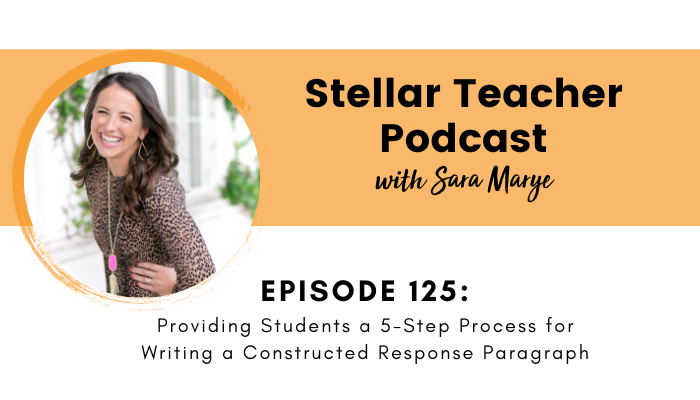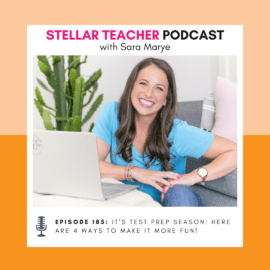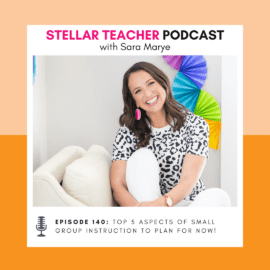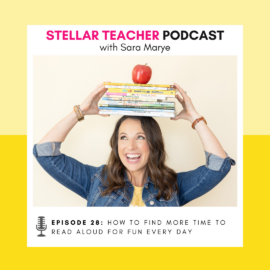
Click play below to hear a 5-step process for writing a constructed response paragraph:
Welcome back to another episode of the podcast! We’re in the middle of a three part series about test prep and ways to make students feel more confident, particularly when writing a constructed response paragraph. We know that this portion of the test can be challenging for students, which is why I’ve come up with a 5-step process that will increase their confidence when writing a constructed response paragraph on test day.
In order to help students be more successful, I breakdown each of the five steps and provide more insight as to the importance of writing a constructed response paragraph. The 5 steps to my process are:
- Read and summarize the text
- Confirm students understand all parts of prompt
- Plan constructed response
- Write constructed response
- Review response
Writing a constructed response paragraph on test day can be difficult for some students. However, by practicing, this process should become more automatic and normal for students in order to help them be more successful when the day comes.
Stay tuned to next week’s episode as we wrap up with five test taking strategies that will help your students feel more confident on test day!
In this episode on writing a constructed response paragraph, I share:
- 5 step framework to writing constructed response paragraph
- Various ways to break down the prompt
- A tip for making the process more automatic for students
- List of review questions as a final checklist for your constructed response paragraph
Resources:
- Check out the Stellar Teacher Reading Membership
- If you’re enjoying this podcast, please leave a review on Apple Podcasts!
Related episodes and blog posts:
- Episode 124, Mastering the Constructed Response: A Teacher’s Guide to Boosting Student Confidence
- Episode 75, 7 Test Prep Strategies for Student Success
- Episode 16, Engaging Test Prep Tips
- My Best Test Prep Tips for Upper Elementary Reading Teachers
Connect with me:
- Join my newsletter
- Shop my TPT store here
- Instagram: @thestellarteachercompany
More About Stellar Teacher Podcast:
Welcome to the Stellar Teacher Podcast! We believe teaching literacy is a skill. It takes a lot of time, practice, and effort to be good at it. This podcast will show you how to level up your literacy instruction and make a massive impact with your students, all while having a little fun!
Your host, Sara Marye, is a literacy specialist passionate about helping elementary teachers around the world pass on their love of reading to their students. She has over a decade of experience working as a classroom teacher and school administrator. Sara has made it her mission to create high quality no-fluff resources and lesson ideas that are both meaningful and engaging for young readers.
Each week, Sara and her guests will share their knowledge, tips, and tricks so that you can feel confident in your ability to transform your students into life-long readers.
Tune in on your favorite podcast platform: Apple, Google, Amazon, Spotify, Stitcher, and more! If you’re loving this podcast, please rate, review, and follow!
Podcast (stellar-teacher-podcast): Play in new window | Download
Hey, there friends, happy Monday. And welcome back to another episode of the podcast. We are currently in a three week series all about test prep. I know you don’t love it, your students don’t love it. But it is something that we want to make sure that they are prepared for.
And so I wanted to carve out some time in this podcast to share with you some really simple test prep strategies, and frameworks that will help you feel confident and helping your students become more confident for the end of your test.
If you are just finding this podcast for the very first time, welcome, so glad you’re here. And if you missed last week’s episode, go back and check out episode number 124, Mastering the Constructed Response: A Teacher’s Guide to Boosting student Confidence. In that episode, I provided just six tips of general things that you can do to help your students feel more confident with the constructed response portion of their tests.
And one of the things that I suggested in that episode is providing students with a process or framework for writing their actual constructed response. And I kind of explained it a little bit. But if you are unsure of how to do that, I have a solution for you. And that’s exactly what I’m going to talk about in this episode.
Obviously, that is like the bulk of coming up with a constructed response. And so I wanted to give you guys a five step process that you can share with your students to help them create a well crafted constructed response. So we’re going to talk about that five step process.
In this podcast episode, I always love sharing really practical and actionable strategies. And this is something that you can start doing with your students today. You’re also want to go to stellarteacher.com/cr, that’s CR for constructed response, to grab a free checklist.
I put together a checklist of the steps that I’m going to share with you in this podcast episode that you can then share with your students. So that way, when you are practicing your constructed response, when you’re just preparing for the test, you can give your students a tangible checklist that they can go through. And they can check things off as they’re getting ready to prepare for their constructed response. So go to stellar teacher.com/cr, to grab the free download that goes with today’s episode. And let’s go ahead and jump right into the five step process for writing a constructed response.
So before students even begin to write their constructed response, they need to have a really thorough understanding of the text. And we want them to understand that reading and summarizing the text is really a key part of crafting a constructed response. So that is the first step, the first step to writing a constructed response is to read and summarize the text.
And your students have probably heard you say that before. And so we want to kind of give them some things that they can do it within this first step so that way, it’s like, you know, yeah, yeah, I read and summarized the text, it’s like, no, no, no, have you done these things?
So, obviously, we want students to read the text. But we also want them to get in the habit of annotating while they’re reading. Annotating is simply them making little notes in the margins, making notes in the text, maybe they underline something that’s important, they might come up with some symbols, you know, if they’ve got a question or you know, there’s a key character, or you know, an important part happened, they might star it.
But annotating the text is going to help them really stay engaged with the reading process, and it’s going to help them just internalize and really synthesize what it is that they are reading at a much higher level than if they didn’t. And then of course, at the very end after they’ve read and annotated the text, we want to have students summarize the text using their own words.
And, you know, this could be something where students at the end, they write out a summary. You can even just get them in the habit, okay, I’ve read the text and I’m going to pause and close my test booklet and I’m going to give a summary in my head, and I’m just going to recount what it is that happened.
And I think this is really important because when students summarize the text using their own words, they are ensuring that they have a clear understanding of the content. And as students are going to respond to the content in a constructed response, they really need to have a strong understanding of it. So step number one, read and summarize the text.
The next step then is to have them confirm that they understand all parts of the prompt. And it’s really important that students understand all parts of the prompt before they begin to write. You know, we don’t want students to just jump right into the writing part, you know, they quickly read the question, and then they put their pencil to the paper and start writing.
So since that’s not the way we want them to go, we really need to teach them to slow down and analyze the prompt before they begin to write. Prompts are often multi step, and students need to make sure that they are fully responding to all parts of the prompt if they want to get full credit for it. So you know, we don’t want students just to answer the first question and forget to provide evidence or, you know, answer one part of it, but forget the other.
So they really need to make sure that they have a clear understanding of what the prompt is asking them to do. So a few things that you can have your students do to make sure they understand the prompt is to first of all identify all of the verbs in the prompt. This is going to help students know that they’re responding in the right way.
You know, oftentimes, a prompt might ask students to identify blank and then explain blank, or it might ask students to state blank and then provide evidence of whatever it is. So make sure that students understand the verbs and what those verbs are asking them to do. Like if the word support is included in the prompt, do students understand what they do with that word, that support means that they’re looking for evidence in the text that they have to find two or three pieces of example that supports their original claim.
So make sure students can identify the verbs and that they understand what the verbs in the prompt mean. And you also want students to be able to determine how many different elements or parts need to be included in the constructed response. And maybe you have students do this with a highlighter, so they can color code the different parts of the question. And then when you’re practicing, they can highlight their answer to make sure that they’ve included all of the parts.
But make sure students understand, okay, this response requires two parts, this response requires three parts. So that way when they’re putting their outline and their response together there including the correct number of elements in their response to fully satisfy the question.
And then the final thing that you can have students do to make sure that they fully understand the prompt, is have them restate the question using their own words. You know, can they take a step back and say, Okay, this question is really asking me to identify the main idea, or this question is asking me to pick the best option and explain why.
Whatever it is, have them practice restating the question using their own words, because then they’re going to feel a lot more confident in their ability to fully respond to the prompt.
So once students understand the prompt, then we want them to plan out their constructed response before just jumping in to responding to it. So step number three is plan your constructed response. And students often don’t take the time to plan and outline their writing, which can cause them to be less intentional, it can cause them to have a weaker response.
And so we want students to actually create an outline for their constructed response. And you can give them a really simple paragraph organization, topic sentence, two to three details and a closing statement or concluding statement if needed, you know, if it’s required of the prompt.
And when students are outlining, they don’t need to write in complete sentences, you know, they can simply list out you know, T S for topic sentence, and then they can even rewrite the question as a statement, they could list out detail number one, detail number two, detail number three, and then they can fill out their outline using symbols or words or abbreviations to help them come up with their thoughts before writing.
And when students take the time to plan their constructed response, they can go back in the text, they can find the text evidence and the details to support their answer, they can think about the order of the details that they want to share, they can take some time to really think about, okay, what is the strongest detail or the strongest evidence that supports my thinking.
Taking time to outline a constructed response kind of gives students that opportunity to take a deep breath, think about what it is that they want to say, and then plan how they’re going to say it. So make sure your students understand that creating an outline and a plan for their constructed response is an important step to take before they jump in and start writing.
Okay, we are on to step number four, which is when the students are actually going to write their constructed response. And this is usually the stuff that students want to rush to, but notice, it’s step number four, meaning there’s quite a few things that students need to have happen, or to think about before they even begin writing their constructed response paragraph at all.
So if students have done steps one, two or three, then they should have an outline, which is going to make writing the constructed response that much easier. But a few things that you could have them do to help them craft their constructive response is have them write their topic sentence. And a really easy way to have students do this is to have them restate the question as a statement.
And if you listened to episode number 124, then you heard me talk about how I suggest doing sentence transformations as a regular part of your test prep practice. And if your students do a daily sentence transformation, then coming up with a topic sentence is no problem for them at all.
So have students write their topic sentence, and then they’re going to simply look at their outline and for every detail that they want to include, or every piece of evidence they want to include in their outline, they’re going to write a complete sentence to explain that detail or that piece of evidence.
So step number four really isn’t that difficult if students have taken the time to break down and analyze the prompt to create their outline, because now all they’re doing is turning their ideas into complete sentences. And again, if you’ve been practicing sentence writing, like I suggested in episode number 124, then this is going to be a piece of cake for your students.
Finally, the last step that students can do and that we want them to do is to review their constructed response and confirm that it fully satisfies the prompt, which means they need to make sure that they’ve answered all parts. So this is where we want students to reread the prompt, you know, make sure that they go back and say, Okay, this prompt was asking me to, and they restated, in their own words, this prompt was asking me to provide two parts to my response, so I’m gonna make sure that there’s two parts in my response.
And then they’re gonna reread their entire answer. And I love giving students kind of a series of questions that they can ask themselves, almost as like this final checklist.
And so some things that you want students to ask themselves as they’re reviewing their constructed response is, first of all, does my response fully respond to the prompt? Am I clear and concise in my explanation? Do I restate the question as a statement as my topic sentence? And do I include details from the text or other pieces of evidence to support my answer?
And if students can answer yes to all four of those questions, then they should feel really confident that they’re answering a constructed response in a really accurate and strong way. So step number five, we definitely want students to review and confirm that their constructed response is completely responding to the prompt.
Now, obviously, students aren’t going to have this checklist with the five steps or those questions we want them to ask at the end on test day. But if you practice this enough with them between now and when they take their test, this process should feel a little more automatic and normal for them. And they shouldn’t really have any questions about what should I be doing on test day.
So let me just quickly review the five steps to helping your students craft a constructed response. Step number one, read and summarize the text. Step number two, confirm that your students understand all parts of the prompt. Step number three, plan your constructed response. Step number four, write your constructed response. And then step number five, review your constructed response and confirm it fully satisfies the prompt.
So hopefully, this helps you feel a little more confident and how you can support your students as they prepare for the constructed response portion of their test. And be sure to go to stellar teacher.com/cr to grab this free download. That includes the checklist of all of the items that I explained in this episode, so that way, you can start using it today with your students when they sit down to practice their constructed response.
And don’t forget, we’ve got one more episode left in our little test prep series. So join me next Monday where I’ll be sharing five test taking strategies that will help your students feel more confident on test day. Have a stellar week.








Leave a Comment
You must be logged in to post a comment.